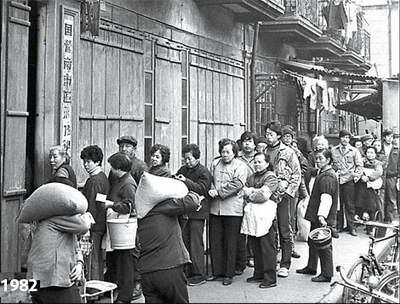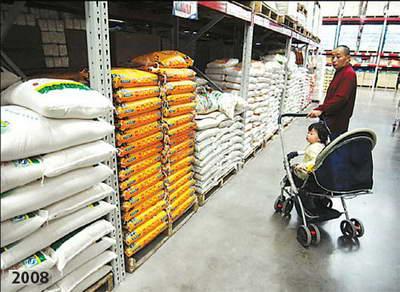Source: China Daily
11-28-2008 18:26
Special Report: 30 Years of ChangesI have heard foreigners complain about Chinese not being accustomed to lining up in order. Wherever they are, in stores or on the road, Chinese always tend to push and cut in line.
One possible explanation for this Chinese habit is that the Chinese used to line up too often, for too many things and for too long. Their current "bold and reckless behavior" is probably a psychological aversion formed during the planned economy.
This is perhaps the reason why this black-and-white photo Wang took in 1982 has become such a classic one. The scene depicted by the photo is very familiar to all Chinese families.
 |
| Photo taken in 1982 (Photographer: Wang Wenlan) |
The photo was taken in Shanghai. The city had by then become the largest modern commercial centre on Chinese mainland. The photo depicts people in front of the State-run No. 72 Grain Store in the southern part of downtown, lining up patiently, even obediently, to get their monthly provisions, with the 19th century-style wooden buildings in the background.
It was a freezing winter day. People on line hid their frozen hands in their pockets or sleeves. The line was so long that it could not be fully captured by Wang´s camera lens. It was very apparent that everyone was in bad mood and no one wanted a chat to pass the time. This was a reflection of the typical Chinese consumer´s life before reform and opening-up.
 |
| Photo taken in 2008 (Photographer: Wang Wenlan) |
In comparison, from the colored photo taken in 2008 in a Sam´s Club in Beijing, we can see that since reform and opening-up, rice supply on the Chinese market has been more than adequate. From 1978 to 2006, Chinese grain output grew from 305 million tons to 500 million tons, up about 60%.
At the same time, urban residents´ per capita grain consumption was on a steady downward slide due to the increase in the supply of meat and other food. Therefore, China does not have to spend a lot of money on imported food so far.
Few countries in the world have been successful in stabilizing their domestic grain supplies while undergoing unprecedented industrial development. Some countries have even turned from grain exporters to grain importers following the take-off of their economies.
However, China´s annual grain output has grown by 60% compared with 30 years ago, given that the size of its arable land has not increased. Over a relatively long period of time, this has contributed to the stability of the world’s food prices. But as a result of global climate changes and some countries using grain for ethanol production, food prices have been rising continuously in the world, and in some areas unbearably high.
Yet, the 1.3 billion Chinese are still lucky enough as they do not have to endure lining up in queues to buy grain. Last week, the State Council announced a new policy to ensure food supply in the country, against the background of global inflation.
We hope that the scene happened in front of the state-run No. 72 Grain Store will never happen again in this country!
Translated by LOTO
Editor:Ying Yu
